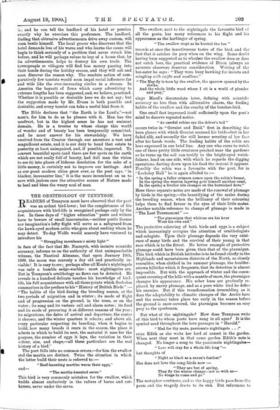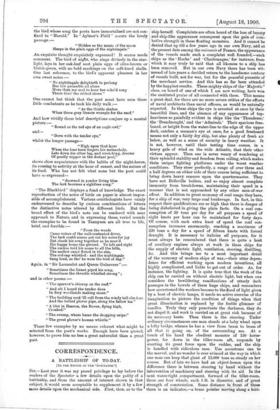THE ORNITHOLOGY OF TENNYSON.
READERS of Tennyson must have observed that the poet was an ardent bird-lover; but the completeness of his acquaintance with bird-life is recognised perhaps only by the few. In these days of "higher education" poets and writers have to beware of small inaccuracies,—neither poetic license nor imagination's lofty flight will serve as a safeguard from the hawk-eyed modern critic who goes about seeking whom he may detect. To-day Wolfe would scarcely have ventured to introduce his
"Struggling moonbeam's misty light" in face of the fact that Mr. Nasmyth, with incisive scientific accuracy, informs us on the authority of that unimpeachable witness, the Nautical Almanac, that upon January 16th, 1809, the moon was scarcely a day old and practically in- visible ! It is easy to err; perhaps after all Seata's nightingale was only a humble sedge-warbler : most nightingales are. But in Tennyson's ornithology no flaws can be detected. He reveals in a hundred delicate touches his knowledge of bird- life, his full acquaintance with all those points which Seebohm summarises in the preface to his " History of British Birds " :— "The habits of the bird during the breeding season, at the two periods of migration and in winter ; its mode of flight and of progression on the ground, in the trees, or on the water; its song and its various call and alarm notes ; its food and its mode of procuring it at different seasons of the year; its migrations, the dates of arrival and departure, the routes it chooses, and the winter quarters it selects; and above all, every particular respecting its breeding, when it begins to build, how many broods it rears in the season, the place it selects in which to build its nest, the material it uses for the purpose, the number of eggs it lays, the variation in their colour, size, and shape,—all these particulars are the real history of a bird."
The poet falls into no common errors,—for him the swallow and the martin are diirthict. Twice the situation in which the latter build their nests is referred to :— " Roof-haunting martins warm their eggs," "The martin-haunted eaves."
This bird is very commonly mistaken for the swallow, which builds almost exclusively in the rafters of barns and out- houses, never under the eaves.
and—
The swallow, next to the nightingale the favourite bird of all the poets, has many references to his flight and his appearance as the harbinger of spring.
"The swallow stopt as he hunted the bee " records at once the insectivorous tastes of the bird, and the fact that it catches its prey when on the wing. Some doubt having been suggested as to whether the swallow does or does not catch bees, the practical evidence of Dixon (always an accurate observer) deserves consideration. Writing of the bee-eater he says : " They were busy hawking for insects and mingling with swifts and swallows."
" The May-fly is torn by the swallow, the sparrow speared by the shrike, And the whole little wood where I sit is a world of plunder and prey," sings Maud's disconsolate lover, defining with scientific accuracy no less than with alliterative charm, the feeding habits of the swallow and the cruelty of the butcher-bird. One small fact impressed itself sufficiently upon the poet's mind to deserve repeated notice.
"As careful robins eye the delver's toil" occurs twice in " G-eraint and Enid," first in describing the keen glance with which Geraint scanned his bride-elect in her faded silk, and secondly the still keener scrutiny of her face after his harsh words. The feeding habits of the robin are here expressed in one brief line. Any one who cares to watch one of these pretty little creatures perched near the gardener as he turns up the soil can testify to the bright-eyed watch- fulness, head on one side, with which he regards the digging operations, darting down upon his food the instant it appears.
Possibly the robin was a favourite with the poet, for in "Locksley Hall" he is again alluded to:— "In the spring a fuller crimson comes upon the robin's breast, In the spring the wanton lapwing gets himself another crest, In the spring a livelier iris changes on the burnished dove."
Here three separate notes are made of the renewal of plumage by birds in the spring,—the beautifying of the males during the breeding season, when the brilliancy of their colouring helps them to find favour in the eyes of their little mates. Another notable reference to change of plumage is made in " The Last Tournament" :— " The ptarmigan that whitens ere his hour Woos his own end."
The protective colouring of both birds and eggs is a subject which increasingly occupies the attention of ornithologists and oologists. Upon their plumage depends the very exist- ence of many birds and the survival of their young in that race which is to the fittest. No better example of protective plumage could have been given than that of the ptarmigan.
This bird, which in British latitudes is to be found chiefly in the Highlands and mountainous districts of the North, so closely resembles, when clothed in its summer plumage, the boulder- strewn hillsides which it frequents, that its detection is almost impossible. But with the approach of winter and the conse- quent covering of the hills with a mantle of snow, the ptarmigan changes his appearance. His sober hues are gradually re- placed by snowy plumage, and as a pure white bird he defies his enemies. But if this transformation (resembling as it does the adaptability to climatic changes of the Arctic hare and the ermine) takes place too early in the season before the ground is snow-covered, the ptarmigan becomes an easy prey to the sportsman.
But what of the nightingale? How does Tennyson write of this bird to whom poets have sung in all ages ? It is the symbol used throughout the love passages in " Harold."
"Mad for thy mate, passionate nightingale . . ." cries Edith as she waits her lord at sunset in the garden. When next they meet in that same garden Edith's note is changed. No longer a song to the passionate nightingales- " Love will stay for a *hole life long "- but thoughts of " Night as black as a raven's feather."
She does not love the song-birds now :-
" They are but of spring, They fly the winter change—not so with us— No wings to come and go."
The metaphor continues, and so the happy birds pass from the poem and the tragedy draws to its end. But references to
the bird whose song the poets have immortalised are not con- fined to " Harold." In " Aylmer's Field " occurs the 'lovely passage:—
"Hidden as the music of the moon Sleeps in the plain eggs of the nightingale."
An exquisite thought exquisitely expressed ! It scarce needs comment. The bird of night, who sings divinely in the star- light, lays in her oak-leaf nest plain eggs of olive-brown or bluish-green, with no bold markings on the soft-hued shells. One last reference, to the bird's apparent pleasure in her own sweet notes :- " No nightingale delighteth to prolong Her low preamble all alone More than my soul to hear her echo'd song Throb thro' the ribbed stone."
One cannot but think that the poet Must have seen these little combatants as he took his daily walk :— " As the thistle shakes When three grey linnets wrangle for the seed."
And how vividly these brief descriptions conjure up a mental picture :— " Round as the red eye of an eagle-owl,"
and—
"Dove with the tender eye,"
whilst the longer passage—
"Nigh upon that hour When the lone Bern forgets his melancholy, Lets down his other leg, and stretching, dreams Of goodly supper in the distant pool," shows close acquaintance with the habits of the night-heron, its rousing to activity at the hour of sunset, and the nature of
its food. Who has not felt what none but. the poet could have so expressed— "drowned in yonder living blue The lark becomes a sightless song."
" The Blackbird " displays a fund of knowledge. The exact reproduction of the notes of birds- on paper is almost impos- sible of accomplishinent. Various ornithologists have vainly endeavoured to describe by curious combinations of letters the distinctive notes uttered by different birds. But the broad effect of the bird's note can be rendered with near approach to Nature, and in expressing these, varied sounds the examples to be found in Tennyson are all true to life, brief, and forcible :—
"From the woods Came voices of the well-contented doves, The lark could scarce get out his notes for joy Bat shook his song together as he near'd His happy home the ground. To left and right The cuckoo told his name to all the hills, The mellow ouzel fluted in the elm, The red-cap whistled : and the nightingale Sang loud, as tho' he were the bird of day."
&gain , in " Sir Launcelot and Queen Guinevere" :— " Sometimes the linnet piped his song, Sometimes the throstle whistled strong"; and in other poems :—
" The sparrow's chirrup on the roof."
" And oft I heard the tender dove In fiery woodlands making moan."
" The building rook 'ill call from the windy tall elm tree And the tufted plover pipe, along the fallow lea."
"A blot in Heaven, the Raven, flying high, Croaked."
" The swamp, wheie hums the dropping snipe." "The great plover's human whistle."
These few examples by no means exhaust what might be selected from the poet's works. Enough have been quoted, however, to prove him no less a great naturalist than a great poet.



































 Previous page
Previous page